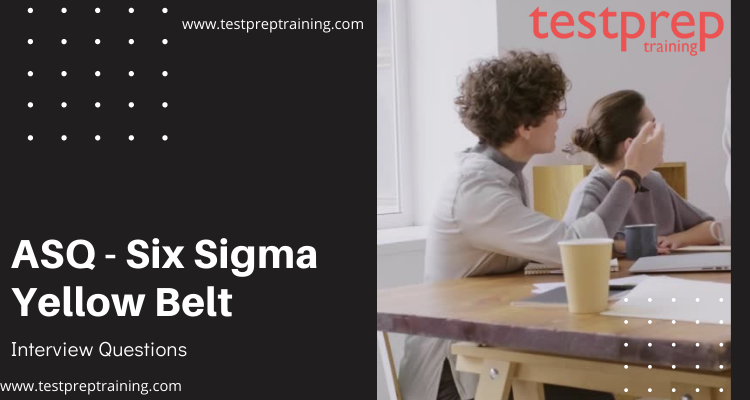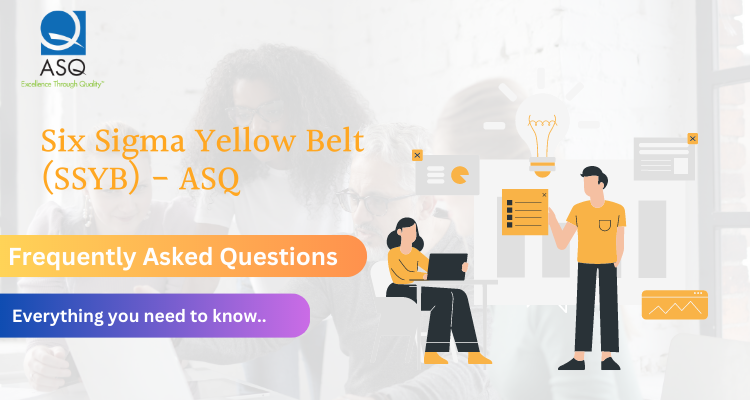ASQ Six Sigma Yellow Belt (SSYB)
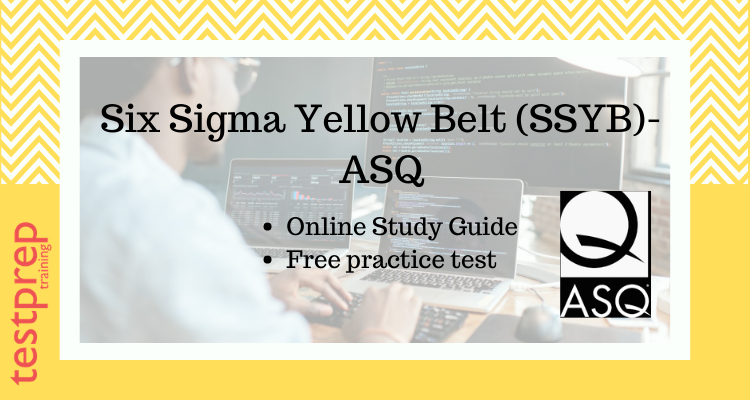
Six Sigma Yellow Belt (SSYB)-ASQ certification is the entry-level examination for those who want to learn the foundation of Six Sigma and also, who seek to improve their world or executive champions which require an overview of Six Sigma and define, measure, analyze, improve and control model (DMAIC).
Skills Acquired
After completing the Six Sigma Yellow Belt, you will acquire and learn the following skills set –
- Enhanced understanding of DMAIC methodology, including the financial benefits of Six Sigma, and the impact of Six Sigma on an organization.
- Improved understanding of project definition as well as team roles and responsibilities.
- A foundational understanding of the measure phase, including process mapping, data collection plans and techniques, understanding variation, and visually displaying baseline performance.
- A foundational understanding of the analysis phase, including displaying data visually, cause and effect analysis, and verification of root causes.
- Foundational learning of the improve phase, including brainstorming, selecting a solution, and implementation planning.
- A foundational understanding of the control phase, including assessing the results of process improvement, statistical process control overview, and documenting the process.
Along with all of these, you will become a valuable asset to your firm, followed by a handsome amount of salary. You will be able to deliver quality and output to your firm’s functioning –
- Supporting projects that are led by Green Belts or Black Belts.
- Assisting Green Belts and Black Belts in data collection, analysis, and process mapping.
- Implementing tools, techniques, and practices to achieve cost reduction and quality improvement.
- Improving overall quality through consistent compliance to defined quality standards.
Required Experience
To start preparing for Six Sigma Yellow Belt, you don’t need any specific qualification or knowledge. All you need is a aim and motivation to get it done. The Certified Six Sigma Yellow Belt is aimed at candidates who have a small role, interest, or need to develop foundational knowledge.
Job Roles – Six Sigma Yellow Belt (SSYB)
After becoming a Six Sigma Yellow Belt certified you can work in the following domains and industries –
- Administrator
- Champion
- Executive
- First-line Operator
- InspectorJunior-Level
- EmployeeManager
- Project Manager
- Quality Analyst
- Representative
Exam Details Six Sigma Yellow Belt (SSYB)
You can appear for the Six Sigma Yellow Belt examination via two methods:
| Computer Delivered mode: | Paper Pencil mode: |
| 85 questions ( out of which 75 questions are scored and 10 are unscored.) | 75 questions are there in total |
| The total exam time is 2 hours and 18 minutes. | The total exam time is 2 hours. |
| This type of exam is only available in English. | This type of exam is only available in English. |
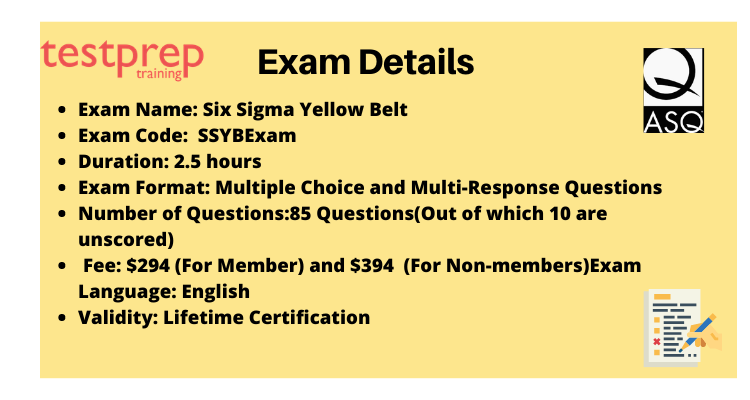
Exam Registration
Follow these steps to successful register yourself for the examination:
- Go to the official ASQ website, or click on the Six Sigma Yellow Belt exam guide.
- On the left-hand side of the page, you may see a box, click on apply now. Also, below apply now, the dates for the next testing window is there. The candidate can choose a date between any of the dates mentioned.
- Login in to your ASQ account or create a new account on ASQ and follow the prompt.
- Post submitting the application, it takes 1-2 business days to review the online applications and 3-5 for hardcopy applications.
- After ASQ completes the review process you will receive an approval notification via email or a “hold” message explaining that more information is needed for your application to be approved. If it is determined that you do not meet exam requirements, you will receive a refund minus a $70 processing fee.
- Computer-Based Testing, CBT:
1-2 business days after you receive your approval notification, you will receive an eligibility email containing instructions on how to schedule your exam with our testing provider Prometric. - Paper-Based Testing, PBT:
If you have registered for a Paper-based or translated exam you will not receive an eligibility email. Instead, you will receive a seating letter with your exam date, time, and location approximately 2 weeks before your exam date. - Schedule your exam appointment in the testing window you chose at the time of application.
Check: ASQ – Six Sigma Yellow Belt Interview Questions
For more information, visit Six Sigma Yellow Belt FAQ.
Course Structure for Six Sigma Yellow Belt
I. Six Sigma Fundamentals (20 Questions)
A. Six Sigma Foundations and Principles
Describe the purpose of Six Sigma (reducing variation), its methodology (DMAIC), and its evolution from quality. Describe the value of Six Sigma to the organization as a whole. (Understand) (ASQ Reference: WHAT IS SIX SIGMA?)
B. Lean Foundations and Principles
Describe the purpose of lean (waste elimination) and its methodologies (just-in-time, poka-yoke, kanban, value stream mapping) and the value of lean to the organization as a whole. (Understand) (ASQ Reference: Lean Foundations)
C. Six Sigma Roles and Responsibilities
‘Define and describe the roles and responsibilities of Six Sigma team members (i.e., individual team members, Yellow Belt, Green Belt, Black Belt, Master Black Belt, process owner, champion, sponsor). (Understand) (ASQ Reference: SIX SIGMA BELTS, EXECUTIVES AND CHAMPIONS – WHAT DOES IT ALL MEAN?)
D. Team Basics
1. Types of teams
Identify the various types of teams that operate within an organization (i.e., continuous improvement, self-managed, and cross-functional) and their value. (Understand) (ASQ Reference: WHAT IS A TEAM?)
2. Stages of development
Describe the various stages of team evolution: forming, storming, norming, performing, and adjourning. (Understand)
3. Decision-making tools
Define brainstorming, multivoting, and nominal group technique (NGT), and describe how these tools are used by teams. (Understand) (ASQ Reference: EVALUATION AND DECISION-MAKING TOOLS)
4. Communication methods
Explain how teams use agendas, meeting minutes, and project status reports, and how they support project success. (Understand) (ASQ Reference: ASQ Communications)
4. Communication methods
Explain how teams use agendas, meeting minutes, and project status reports, and how they support project success. (Understand)
E. Quality Tools and Six Sigma Metrics
1. Quality tools
Select and use these tools throughout the DMAIC process: Pareto charts, cause and effect diagrams, flowcharts, run charts, check sheets, scatter diagrams, and histograms. (Apply) (ASQ Reference: QUALITY TOOLS)
2. Six Sigma metrics
Select and use these metrics throughout the DMAIC process: defects per unit (DPU), defects per million opportunities (DPMO), rolled throughput yield (RTY), cycle time, and cost of poor quality (COPQ). (ASQ Reference: SIX SIGMA ROLES)
II. Define Phase (14 Questions)
A. Project Identification
1. Voice of the customer
Define the voice of the customer and describe how customer needs are translated into quantifiable, critical-to-quality (CTQ) characteristics. (Understand) (ASQ Reference: VOICE OF THE CUSTOMER TABLE (VOCT))
2. Project selection
Describe how projects are identified and selected as suitable for a Six Sigma project using the DMAIC methodology. (Understand) (ASQ Reference: Project Selection)
3. Stakeholder analysis
Identify end users, subject matter experts, process owners, and other people or factors that will be affected by a project, and describe how each of them can influence the project. (Understand) (ASQ Reference: IDENTIFYING STAKEHOLDERS)
4. Process inputs and outputs
Use SIPOC (suppliers, inputs, process, outputs, customers) to identify and define important elements of a process. (Apply)
B. Project Management (PM) Basics
1. Project charter
Describe the purpose of a charter and its components: problem statement, project scope, baseline data, and project goal. (ASQ Reference: Project Charter)
2. Communication plan
Explain the purpose and benefits of a communication plan and how it can impact the success of the project. (Understand) (ASQ Reference: ASQ Communications)
3. Project planning
Define work breakdown structure (WBS) and Gantt charts, and describe how they are used to plan and monitor projects. (Understand) (ASQ Reference: PROJECT PLANNING AND IMPLEMENTATION TOOLS)
4. Project management tools
Select and use various PM tools: activity network diagrams, affinity diagrams, matrix charts, relations charts, and tree diagrams. (Understand)
5. Phase reviews
Explain how tollgate or phase reviews are used throughout the DMAIC life cycle. (Understand) (ASQ Reference: THE DMAIC PROCESS)
III. Measure Phase (15 Questions)
A. Basic Statistics
Define, calculate, and interpret measures of central tendency (mean, median, mode) and measures of dispersion (standard deviation, range, variance). (Apply) (ASQ Reference: Measure Phase Checklist)
B. Data Collection
1. Data collection plans
Describe the critical elements of a data collection plan, including an operational definition, data sources, the method to be used for gathering data, and how frequently it will be gathered. Describe why data collection plans are important. (Understand) (ASQ Reference: Data Collection)
2. Qualitative and quantitative data
Define and distinguish between these types of data. (Understand)
3. Data collection techniques
Use various data collection techniques, including surveys, interviews, check sheets, and checklists to gather data that contributes to the process being improved. (Apply) (ASQ Reference: Data Collection)
C. Measurement System Analysis (MSA)
1. MSA terms
Define precision, accuracy, bias, linearity, and stability, and describe how these terms are applied in the measurement phase. (Understand) (ASQ Reference: Measurement System Analysis (MSA))
2. Gauge repeatability and reproducibility (GR&R)
Describe how and why GR&R is used in the measurement phase. (Understand) (ASQ Reference: GAGE REPEATABILITY AND REPRODUCIBILITY)
IV. Analyze Phase (17 Questions)
A. Process Analysis Tools
1. Lean tools
Define how 5S and value analysis can be used to identify and eliminate waste. (Understand) (ASQ Reference: Lean Essentials)
2. Failure mode and effects analysis (FMEA)
Define the elements of severity, opportunity, and detection, and determine how they are used to calculate the risk priority number. Describe how FMEA can be used to identify potential failures in a process. (Understand) (ASQ Reference: Failure Mode And Effects Analysis – Managing Risk)
B. Root Cause Analysis
Describe how the 5 Whys, process mapping, force-field analysis, and matrix charts can be used to identify the root causes of a problem. (Understand) (ASQ Reference: ROOT CAUSE ANALYSIS)
C. Corrective action
Explain and apply elements of the corrective action process: identify the problem, contain the problem (interim action), determine the causes of the problem and propose solutions to eliminate it or prevent its recurrence (permanent action), verify that the solutions are implemented, and confirm their effectiveness (validation). (Apply)
D. Preventive action
Explain and apply elements of a preventive action process: understand various process analysis techniques to identify potential failures, defects, or process deficiencies; improve the process (e.g., understand error- or mistake-proofing devices or methods, initiate procedural changes), and verify the effectiveness of the preventive action. (Apply)
E. Data Analysis
1. Basic distribution types
Define and distinguish between normal and binomial distributions and describe how their shapes (skewed and bimodal) can affect data interpretation. (Understand) (ASQ Reference: Data Analysis)
2. Common and special cause variation
Describe and distinguish between these types of variation. (Understand) (ASQ Reference: LAW OF VARIATION)
F. Correlation and Regression
1. Correlation
Describe how correlation is used to identify relationships between variables. (Understand) (ASQ Reference: Correlation And Regression)
2. Regression
Describe how regression analysis is used to predict outcomes. (Understand)
G. Hypothesis Testing
Define and distinguish between hypothesis terms (i.e., null and alternative, type I and type II error, p-value and power). (Understand) (ASQ Reference: Hypothesis Testing)
V. Improve and Control Phases (14 Questions)
A. Improvement Techniques
1. Kaizen and kaizen blitz
Define and distinguish between these two methods and describe how they can be used to make improvements to any process in an organization. (Understand) (ASQ Reference: Kaizen Blitz Road Map)
2. Plan-do-check-act (PDCA) cycle
Define and distinguish between the steps in this process improvement tool. (Understand) (ASQ Reference: PDCA CYCLE)
3. Cost-benefit analysis
Explain the importance of this analysis and how it is used in the improve phase. (Understand) (ASQ Reference: Cost Of Quality)
B. Control Tools and Documentation
1. Control plan
Describe the importance of a control plan for maintaining improvements. (Understand) (ASQ Reference: Process Control Plan)
2. Control charts
Describe how X-R charts are used for monitoring and sustaining improved processes. (Understand) (ASQ Reference: CONTROL CHART)
3. Document control
Describe the importance of documenting changes to a process and communicating those changes to stakeholders. (Understand) (ASQ Reference: Document Control System)
Preparatory Guide For Six Sigma Yellow Belt Exam
Preparing with the right resources is the key to clear any exam. Moreover, you need consistency and determination throughout your journey towards the exam. Further, you must follow a study pattern while learning from authentic and genuine resources. This Preparatory Guide will act as a bridge for your career advancements. Success can be achieved only with the right methodology and determination. Let’s discuss step by step-
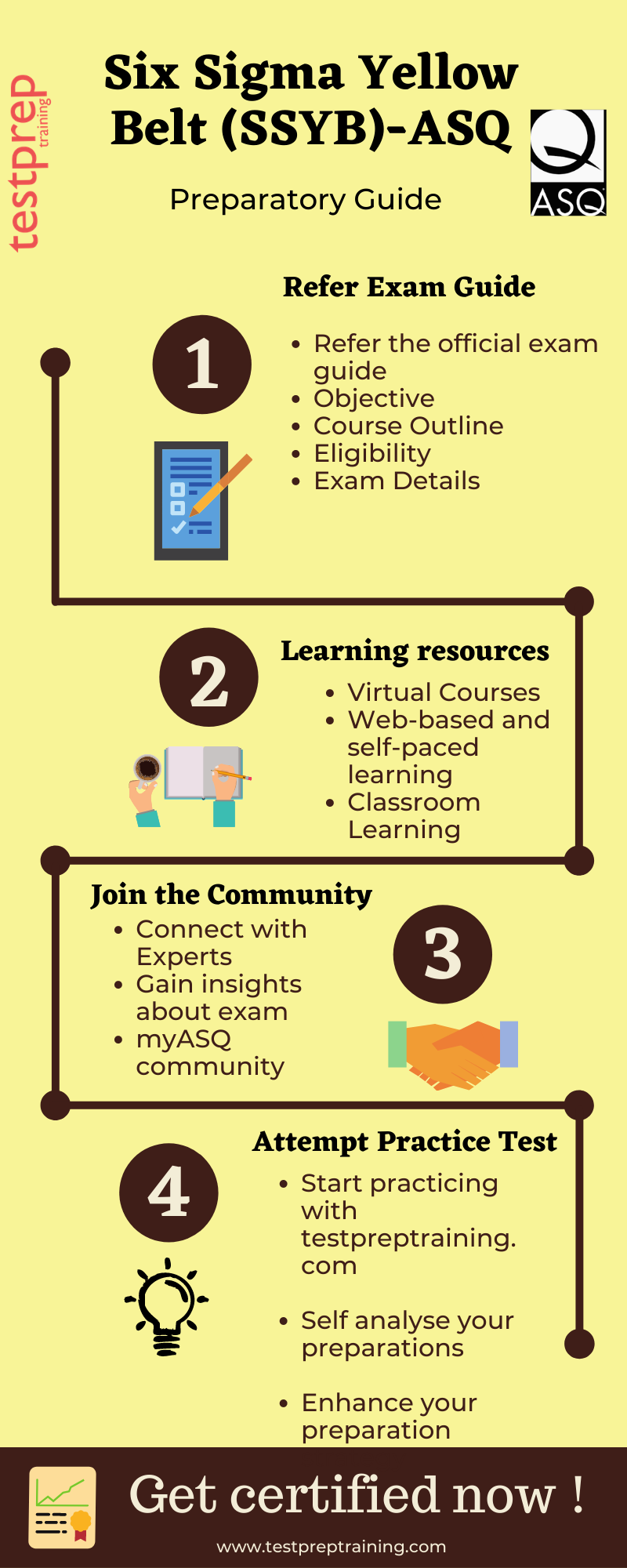
Exam Simulator
Provides sample exam questions based on the Certified ASQ – Six Sigma Yellow Belt. You can use the question sets in two different modes — Exam simulation or review mode.
CSSBB Books
ASQ also provides a handbook to ease your exam preparation process and also to help you in appearing for the open book exam. This will help you prepare well in the examination. Along with this book, ASQ also provides free sample questions and answers to give you an insight into the examination.
- ASQ CSSGB HandBook: For your open book exam.
Certification Preparation: SSGB
Classroom
The format of this course is an instructor-led traditional classroom and includes classroom-based instruction involving the highest level of instructor/student interaction. The classroom-style training is provided in two formats. See the public and on-site.
Web-based and self-paced learning
This course is web-based and self-paced. It includes internet-based, self-paced training modules, which may involve combinations of text, visuals, audio, interactive simulations, and quizzes. This course does not teach but rather reviews concepts in the handbook. These web-based courses require a computer and Internet access.
Virtual
These Virtual courses are for Yellow Belts, individuals supporting Six Sigma projects, and/or individuals looking to achieve their ASQ Six Sigma Yellow Belt certification. Use of real-world examples and activities are done, this course is designed to help you prepare for the ASQ SSGB certification exam. This course reviews concepts in the SSGB BoK. ASQ also offers this training course in an instructor-led classroom setting. On-site training is available for groups of five or more, offering convenience, cost-savings, and even course customization when you bring our premier instructors to your organization. Please note that this course is in no way a guarantee of a passing score on the ASQ – Six Sigma Yellow Belt exam.
Group Training
This initiative of ASQ provides an on-site training facility for the organization. You as an employer can train and update your employees as per your own schedule. This also minimizes the cost-per-student, reduces travel expenses, and ensures that the content is specific to your exact needs. This ensures the ASQ – Six Sigma Yellow Belt certification on a mass level.
Communities
myASQ communities are utilized for networking, sharing content, and peer-to-peer learning. Some of these communities are gated and are determined by your member profile. Membership in technical and geographic communities are included or can be added to an ASQ membership.
Practice Test and Evaluate
To ace anything you need to practice it and for the practice, you need sample papers and test series which will give you the experience of the real-time examination. We at Testprep provides you with the test series, specially designed for Six Sigma Yellow Belt. These practice tests are based on the actual exams i.e. you can get assured success if you take these practice tests. So, Start Practicing Now and get ASQ – Six Sigma Yellow Belt Certified.

